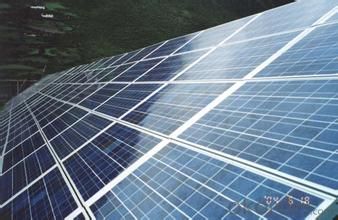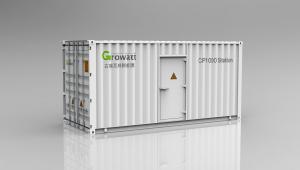Centralized Solar Inverter CP1000 Station,1260KW with TUV,EPEA,MEA,CE,CGC,LVRT,ZVRT 1.26MW
- Loading Port:
- Shekou
- Payment Terms:
- TT or LC
- Min Order Qty:
- 20 pc
- Supply Capability:
- 1000 pc/month
OKorder Service Pledge
OKorder Financial Service
You Might Also Like
1000kW integrated central inverter solution with DC distributed box and ac distributed box.
High conversion efficiency of 98.7% deliver more energy
Powerful grid management functions (including LVRT)
Active power continuous adjustment (0-100%)
Reactive power continuous adjustment (0-100%)
Integrated with SCADA monitoring system, totally compatible with smart-grid interface
Intelligent control, entirely meet the requirements of grid
Provide a turnkey solution, easy installation and maintenance
Comprehensive protection for overvoltage, islanding, short-circuit, overload, etc.
| CP1000 Station | CP1260 Station | |||
| Input data | ||||
| Max. DC power | 1150kW | 1450kW | ||
| Max. DC voltage | 1000V | 1000V | ||
| PV voltage range | 500V-1000V | 500V-1000V | ||
| MPP voltage range/nominal voltage | 500V-850V | 500V-850V | ||
| Rated Input voltage | 600V | 600V | ||
| Start voltage/power | 520V/10000W | 520V/12600W | ||
| Maximum Input current | 2240A | 2900A | ||
| Number of MPP trackers/strings per MPP tracker | 1 | 1 | ||
| Max. input current/per string | 2*10 | 2*10 | ||
| Output (AC) | ||||
| Rated AC output power | 1000kVA | 1000kVA | ||
| Rated AC voltage | 315V | 315V | ||
| AC voltage range | 250V-362V | 250V-362V | ||
| Rated frequency | 50Hz/60Hz | 50Hz/60Hz | ||
| Frequency Range | 45Hz-55Hz/55Hz-65Hz | 45Hz-55Hz/55Hz-65Hz | ||
| Rated Output Current | 1833A | 2310A | ||
| Maximum Output Current | 2016A | 2592A | ||
| Power factor | 0.9lagging-0.9leading | 0.9lagging-0.9leading | ||
| THDI | <3%(@Pac,r) | <3%(@Pac,r) | ||
| Efficiency | ||||
| Max. efficiency | 98.70% | 98.70% | ||
| Euro-eta | 98.50% | 98.50% | ||
| MPPT efficiency | 99.9% | 99.90% | ||
| Protection Devices | ||||
| DC disconnection device | DC circuit breaker | DC circuit breaker | ||
| AC disconnection device | AC circuit breaker | AC circuit breaker | ||
| DC overvoltage protection | Surge arrester type II | Surge arrester type II | ||
| AC overvoltage protection | Surge arrester type II | Surge arrester type II | ||
| Grid monitoring/Management | yes/yes | yes/yes | ||
| Ground monitoring | yes | yes | ||
| Over temperature protection | yes | yes | ||
| Insulation monitoring | yes | yes | ||
| General data | ||||
| Dimension (W/H/D)in mm | 3600/3000/2896 | 3600/3000/2896 | ||
| Weight | 6000KG | 6000KG | ||
| Operating Temperature Range | -25℃ ... +55℃ | -25℃ ... +55℃ | ||
| Relative Humidity | 0~95% | 0~95% | ||
| Degree of Protection | IP54 | IP54 | ||
| Noise Emission | 65dB(A)@1m | 65dB(A)@1m | ||
| Maximum Operating Altitude | 6000m(Derating over 3000m) | 6000m(Derating over 3000m) | ||
| Standby consumption | <200W | <200W | ||
| Cooling | Air forcedl | Air forcedl | ||
| Topology | Transformerless | Transformerless | ||
| Display | Touch screen LCD | Touch screen LCD | ||
| Communication Interface | RS485/Ethernet | RS485/Ethern | ||
| Certificates and ApprovalsCE, TUV, CGC, LVRT, ZVRT, PEA, G59 | ||||


FAQ
1. Have any design tool and how to use it?
Shine Design is the system design software just for inverters, It can conduct installers to figure out panel numbers for a system, panel numbers for each string, and which inverter model is suitable for the system. Moreover, it can print a design report after input all necessary parameters, can calculate DC/AC wire wastage, annual generation, etc.
2. Does the inverter have monitoring solutions for residential system?
For small rating system, we have wired two monitoring solution (ShineNet via RS232 or RS485). (a) Local wireless monitoring solution (ShineVision via RF module communication) (b) Global wireless monitoring solution (WIFI module via WIFI network)
3. Do you have free solution for monitoring?
ShineNet is an inverter monitoring software run in Windows XP, Windows Vista, Windows 7 operating system. It can monitor inverter via RS232 (or RS232 convert to USB cable) and RS485 wire connection. Customers can purchase the cable locally to get the inverter monitored, it is simple.
- Q:Can a solar inverter be used with solar-powered air conditioning systems?
- Yes, a solar inverter can be used with solar-powered air conditioning systems. The solar inverter is responsible for converting the direct current (DC) generated by the solar panels into alternating current (AC) that can be used to power various electrical appliances, including air conditioning units. By connecting the solar inverter to the solar panels and the air conditioning system, the generated solar energy can be efficiently utilized to power the AC system.
- Q:Can a solar inverter be connected to a generator?
- Yes, a solar inverter can be connected to a generator. This can be useful in situations where solar power is not sufficient or unavailable, allowing the generator to supplement the power supply.
- Q:Can a solar inverter be used in countries with different electrical standards?
- Yes, a solar inverter can be used in countries with different electrical standards. However, it may require certain modifications or adjustments to ensure compatibility with the local electrical infrastructure. Additionally, the input voltage and frequency of the solar inverter may need to be adjusted accordingly. It is important to consult with local experts or electricians to ensure proper installation and compliance with the electrical standards of the country.
- Q:What are the different power output modes of a solar inverter?
- The different power output modes of a solar inverter include grid-tie mode, off-grid mode, and hybrid mode. In grid-tie mode, the inverter synchronizes with the utility grid and feeds excess solar power back to the grid. Off-grid mode allows the inverter to operate independently from the grid, providing power to a standalone system or battery storage. Hybrid mode combines both grid-tie and off-grid capabilities, enabling the inverter to utilize solar power while still being connected to the grid for backup or additional power supply.
- Q:Can a solar inverter be used with different brands of solar panels?
- Yes, a solar inverter can generally be used with different brands of solar panels as long as they have compatible specifications and operating voltages. However, it is important to consult the manufacturer's guidelines or seek professional advice to ensure compatibility and optimal performance.
- Q:How does the input power rating affect the performance of a solar inverter?
- The input power rating directly affects the performance of a solar inverter. A higher input power rating allows the inverter to handle larger amounts of power generated by the solar panels. This means that a higher input power rating can lead to better efficiency and performance of the solar inverter, as it can convert a greater amount of solar energy into usable electricity. Conversely, a lower input power rating may limit the inverter's capacity to handle high power outputs, potentially resulting in reduced efficiency and performance.
- Q:Is the grid side of the grid and the inverter?
- Grid-type system power transmission sequence: photovoltaic panels> relays> inverters> relays> electricity load + power grid (both in parallel).
- Q:Can a solar inverter be used in a commercial or industrial setting?
- Yes, a solar inverter can be used in a commercial or industrial setting. In fact, they are commonly used in these settings to convert the direct current (DC) electricity generated by solar panels into alternating current (AC) electricity that can be used to power various commercial and industrial equipment. Solar inverters are essential components of solar power systems in such settings and play a crucial role in maximizing energy efficiency and reducing reliance on conventional power sources.
- Q:Can a solar inverter be used for residential applications?
- Yes, a solar inverter can be used for residential applications. In fact, it is commonly used in residential solar power systems to convert the direct current (DC) generated by solar panels into alternating current (AC) that can be used to power household appliances and electronics.
- Q:Can a solar inverter be used in a floating solar system?
- Yes, a solar inverter can be used in a floating solar system. In fact, a solar inverter is an essential component of any solar power system, including floating solar systems. The purpose of a solar inverter is to convert the direct current (DC) electricity produced by the solar panels into alternating current (AC) electricity that can be used to power electrical appliances or be fed into the grid. Whether the solar panels are installed on the ground, on rooftops, or on a floating platform, a solar inverter is necessary to ensure the efficient and safe conversion of solar energy into usable electricity.
1. Manufacturer Overview |
|
|---|---|
| Location | |
| Year Established | |
| Annual Output Value | |
| Main Markets | |
| Company Certifications | |
2. Manufacturer Certificates |
|
|---|---|
| a) Certification Name | |
| Range | |
| Reference | |
| Validity Period | |
3. Manufacturer Capability |
|
|---|---|
| a)Trade Capacity | |
| Nearest Port | |
| Export Percentage | |
| No.of Employees in Trade Department | |
| Language Spoken: | |
| b)Factory Information | |
| Factory Size: | |
| No. of Production Lines | |
| Contract Manufacturing | |
| Product Price Range | |
Send your message to us
Centralized Solar Inverter CP1000 Station,1260KW with TUV,EPEA,MEA,CE,CGC,LVRT,ZVRT 1.26MW
- Loading Port:
- Shekou
- Payment Terms:
- TT or LC
- Min Order Qty:
- 20 pc
- Supply Capability:
- 1000 pc/month
OKorder Service Pledge
OKorder Financial Service
Similar products
New products
Hot products
Hot Searches
Related keywords
































